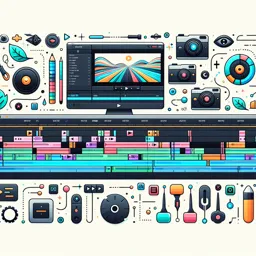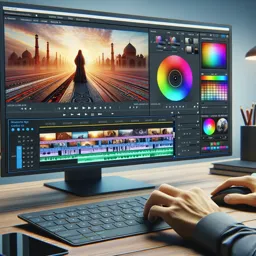Video editing is a powerful tool in the art of storytelling, transforming raw footage into compelling narratives that captivate audiences. The process involves much more than simply cutting and splicing clips together; it requires a keen understanding of the story, the ability to manipulate pacing, and the skill to enhance the emotional impact of the visuals. In this article, we will explore how video editors can master the art of storytelling through their craft.
Understanding the Story
The first step in effective storytelling through video editing is understanding the story you want to tell. This involves grasping the plot, the characters, and the message you wish to convey. Before diving into the editing software, take the time to review the script, if available, and watch all the footage. Identify key moments, emotions, and themes that need to be highlighted.
Manipulating Pacing
Pacing is crucial in storytelling. It determines how fast or slow the narrative unfolds, influencing the audience’s emotional response. A well-paced video keeps viewers engaged and enhances the dramatic effect of the story. Here are some tips for manipulating pacing in your edits:
- Cutting to the Beat: Syncing your cuts to the rhythm of the background music can create a seamless and engaging flow.
- Using Long Takes: Long takes can build tension and allow the audience to immerse themselves in the scene.
- Quick Cuts: Quick cuts can convey urgency, excitement, or chaos, depending on the context.
Enhancing Emotional Impact
The emotional impact of a story is often what makes it memorable. As an editor, you have various tools at your disposal to enhance emotions:
- Music and Sound Effects: The right music can evoke specific emotions and set the tone for a scene. Sound effects can also add realism and depth.
- Color Grading: Color grading can dramatically alter the mood of your footage. Warm colors might evoke happiness or nostalgia, while cooler tones can create a sense of calm or sadness.
- Visual Effects: Subtle visual effects can enhance the storytelling. For instance, a slow-motion effect can emphasize a crucial moment, while a fade can signify the passage of time.
Transitions and Effects
Transitions and effects should be used thoughtfully to aid storytelling rather than distract from it. Smooth transitions can help maintain the narrative flow, while more noticeable effects can be used to highlight significant shifts in the story. Common transitions include:
- Cuts: The most basic and frequently used transition, cuts are effective in maintaining a straightforward narrative flow.
- Dissolves: Dissolves can signify a change in time or location, providing a softer transition between scenes.
- Wipes and Fades: These can be used to signify a significant change or passage of time, adding to the storytelling.
Collaboration and Feedback
Collaboration is an integral part of the video editing process. Working closely with directors, writers, and other creatives ensures that the story is told as intended. Regular feedback sessions can provide new insights and help refine the narrative. Don’t hesitate to experiment with different approaches based on the feedback you receive.
Conclusion
Mastering the art of storytelling through video editing requires practice, creativity, and a deep understanding of the narrative. By focusing on pacing, emotional impact, and thoughtful transitions, video editors can transform raw footage into powerful stories that resonate with audiences. Remember, the tools and techniques at your disposal are only as effective as the story you aim to tell. Keep honing your craft, stay open to feedback, and let your creativity guide you in creating compelling visual narratives.
































